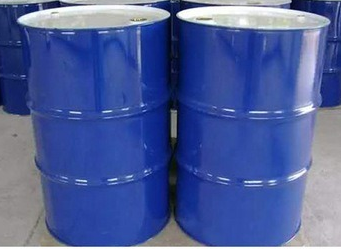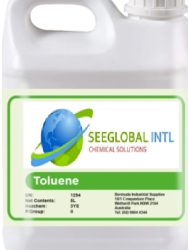Description
Commercial or mixed xylene usually contains about 40-65% m-xylene and up to 20% each of o-xylene and p-xylene and ethylbenzene. Xylenes are released into the atmosphere as fugitive emissions from industrial sources, from auto exhaust, and through volatilization from their use as solvents. Acute (short- term) inhalation exposure to mixed xylenes in humans results in irritation of the eyes, nose, and throat, gastrointestinal effects, eye irritation, and neurological effects. Chronic (long-term) inhalation exposure of humans to mixed xylenes results primarily in central nervous system (CNS) effects, such as headache, dizziness, fatigue, tremors, and incoordination; respiratory, cardiovascular, and kidney effects have also been reported. EPA has classified mixed xylenes as a Group D, not classifiable as to human carcinogenicity.
Xylene Uses
4-Xylene is a colorless liquid. It is also a colorless plate or prism at low temperatures. It has a sweet aromatic odor. 4-Xylene is slightly soluble in water. It occurs naturally in petroleum and coal tar. 4-Xylene is formed during forest fires and is naturally given off from corn, alfalfa and cereal silage. USE: 4-Xylene is an important commercial chemical that is used to make other chemicals, polyester resins and fibers, in the manufacture of vitamins and insecticides and in paint and paint products. It is typically found in a mixture with other xylenes (2- and 3-xylene). EXPOSURE: Workers that use 4-xylene may breathe in mists or have direct skin contact. The general population may be exposed by breathing air, eating food and drinking water, smoking cigarettes and contact with consumer products containing xylenes (gasoline, paints, varnishes, paint thinner, etc.). If 4-xylene is released to the environment, it will be broken down in air. It is not expected to be broken down by sunlight. It will move into air from moist soil and water surfaces. It is expected to move moderately through soil. It will be broken down by microorganisms, and is not expected to build up in fish. RISK: Risks discussed below are for xylene mixtures in general, as 4-xylene is most often found in a mixture with 2- and 3-xylene. Studies indicate that risk of toxicity is the same for 2-, 3-, and 4-xylene, or a mixture of the three chemicals. Xylenes are skin, eye, nose, and throat irritants. Nervous system effects (headache, dizziness, confusion, incoordination, impaired balance, forgetfulness, etc.) are the primary effects observed in humans that breathe high levels of xylenes. Difficulty breathing, nausea, and damage to the lungs, liver, and kidneys have also been observed following exposure to high vapor levels. Unconsciousness and even death may occur at very high levels. Similar effects were noted in laboratory animals exposed to moderate-to-high levels of xylenes. Studies on the potential for xylenes to cause infertility, abortion, or birth defects in humans are considered inadequate to assess risk due to simultaneous exposure to other solvents (e.g. benzene). Abortion and delayed growth and development of offspring were observed in laboratory animals following exposure to xylene during pregnancy, but only at doses that were toxic to the mothers. Infertility and major birth defects were not observed in laboratory animals following exposure before and/or during pregnancy. No specific forms of cancer have been specifically associated with xylene exposure in workers exposed to solvent mixtures (including xylenes). No evidence of cancer was observed in laboratory animals following lifetime oral exposure to xylenes. The U.S. EPA IRIS program determined that data are inadequate for an assessment of the human carcinogenic potential of xylenes. The International Agency for Research on Cancer has determined that xylenes are not classifiable as to their carcinogenicity to humans based on lack of adequate human data and inconclusive animal data. The potential for xylene to cause cancer in humans has not been assessed by the U.S. National Toxicology Program 13th Report on Carcinogens. (SRC).
Molecular Formula – C6H4(CH3)2 or C8H10
Synonyms – P-XYLENE 1,4-Dimethylbenzene, Para-Xylene. 106-42-3, 1,4 Xylene
Molecular Weight – 106.16 g/mol
|
Molecular Weight |
106.16 g/mol |
|
XLogP3 |
3.2 |
|
Exact Mass |
106.07825 g/mol |
|
Monoisotopic Mass |
106.07825 g/mol |
|
Topological Polar Surface Area |
0 Ų |
|
Heavy Atom Count |
8 |
|
Complexity |
48.4 |
|
Compound Is Canonicalized |
Yes |
Physical Properties
Description: Clear, colorless liquid
Warning properties: Adequate; sweet, aromatic odor at 1 ppm
Molecular weight: 106.2 daltons
Boiling point (760 mm Hg)*: 292°F (144°C), 269°F (139°C), and 281°F (138°C)
Freezing point*: -13°F (-25°C), -54°F (-48°C), and 56°F (13°C)
Specific gravity*: 0.88, 0.86, and 0.86 (water = 1)
Vapor pressure*: 5, 6, and 6.5 mm Hg at 68°F (20°C)
Gas density: 3.8 (air = 1)
Water solubility: insoluble
Flammability*: 63°F (17°C), 81°F (27°C), 81°F (27°C)
Flammable range: 1.0% to 7.0% (concentration in air)
|
Signal |
Danger |
|
GHS Hazard Statements |
Aggregated GHS information provided by 1282 companies from 22 notifications to the ECHA C&L Inventory. Each notification may be associated with multiple companies. H226 (100%): Flammable liquid and vapor [Warning Flammable liquids] H304 (10.3%): May be fatal if swallowed and enters airways [Danger Aspiration hazard] H312 (99.84%): Harmful in contact with skin [Warning Acute toxicity, dermal] H315 (100%): Causes skin irritation [Warning Skin corrosion/irritation] H319 (44.93%): Causes serious eye irritation [Warning Serious eye damage/eye irritation] H332 (100%): Harmful if inhaled [Warning Acute toxicity, inhalation] H335 (10.45%): May cause respiratory irritation [Warning Specific target organ toxicity, single exposure; Respiratory tract irritation] H412 (15.6%): Harmful to aquatic life with long lasting effects [Hazardous to the aquatic environment, long-term hazard] Information may vary between notifications depending on impurities, additives, and other factors. The percentage value in parenthesis indicates the notified classification ratio from companies that provide hazard codes. Only hazard codes with percentage values above 10% are shown. |
Safety Information
Health and Safety Symbols and Their Meanings Safety Symbols and Their Meanings – DAWCO n-Propyl Bromide (nPB) Determined Unacceptable Risk by EPA for Vapor Degreasing & Aerosols, Chemtronics offers nPB replacements. | Chemtronics
Paraxylene is predominantly an industrial chemical. Therefore, most opportunities for human exposure to paraxylene occur at the industrial facilities where it is handled.
Because paraxylene is flammable, industrial facilities handle it with safety in mind, with procedures to avoid exposure to possible ignition sources and by ventilating storage areas. Industrial facilities also have procedures to avoid accidental release into the environment and to store paraxylene in an appropriate containment system in a cool, well-ventilated area.
Paraxylene is generally considered to have low acute toxicity at levels found in the workplace. Exposure to high levels of paraxylene vapors can lead to drowsiness and dizziness, and contact exposure to the skin and eyes may result in dry skin, redness and irritation. If swallowed and then coughed up and inhaled into the lungs, paraxylene can cause lung damage or chemical pneumonia.
Workers with questions about paraxylene should consult the Safety Data Sheet and their employer for more information.








Reviews
There are no reviews yet.